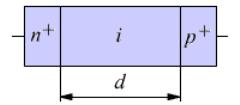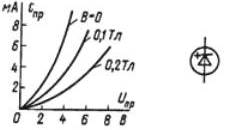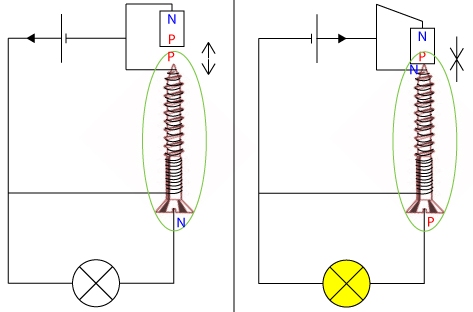What are magnetodiodes and where are they used
A magnetodiode is a type of semiconductor diode, the current-voltage characteristic of which can change under the influence of a magnetic field.
Normal semiconductor diode has a thin base so that the magnetic field slightly changes its current-voltage characteristic. While magnetodiodes are distinguished by a thick (long) base, with which the path length for the current significantly exceeds the dissipated length of the carriers injected into the base.
The traditional thickness of the base is only a few millimeters, and its resistance is comparable to the direct resistance p-n-junction… As the induction of the magnetic field directed through it increases, the resistance of the base increases significantly, similar to that of a magnetoresistor.

In this case, the total resistance of the diode also increases, and the forward current decreases.This current reduction phenomenon is also due to the fact that when the base resistance becomes larger, the voltage is redistributed, the voltage drop across the base increases, and the voltage drop across the p-n junction decreases and the current decreases accordingly.
The effect of the magneto-diode can be quantitatively investigated by looking at the current-voltage characteristic of the magnetodiode, which is shown in the figure. Here it is evident that as the magnetic induction increases, the forward current decreases.

The fact is that the magnetodiode differs from ordinary semiconductor diodes in that it is made of a semiconductor with a high resistance, the conductivity of which is close to its own, and the length of the base d is several times greater than the deviation length of the diffuse carrier L .While in ordinary diodes d is less than L.
Note that magneto diodes are characterized by a larger forward voltage drop, unlike classic diodes, which is precisely due to the increased resistance of the base. In other words, a magnetodiode is a semiconductor device with a pn junction and non-rectifying contacts between which there is a high-resistance semiconductor region.
Magnetic diodes are made of semiconductors not only with high resistance, but also with the greatest possible mobility of charge carriers. Often, the structure of the p-i-n magnetodiode, while the region i is elongated and has a significant resistance, it is precisely in this that a pronounced magnetoresistive effect is observed. In this case, the sensitivity of magnetic diodes to changes in magnetic induction is higher than that of Hall sensors made of the same material.
For example, for KD301V magnetodiodes at B = 0 and I = 3 mA, the voltage drop across the diode is 10 V, and at B = 0.4 T and I = 3 mA — about 32 V. In the forward direction at high injection levels, the conduction of the magnetodiode is determined nonequilibrium carriers injected into the base.
The voltage drop occurs mainly not at the p-n junction, as in a conventional diode, but at a base with high resistance. If the current-carrying magnetic diode is placed in a transverse magnetic field B, then the base resistance will increase. This will cause the current through the magnetic diode to decrease.
In «long» diodes (d / L> 1, where d is the length of the base, L is the effective length of the diffusion bias), the carrier distribution and therefore the resistance of the diode (base) is precisely determined by the length L.
A decrease in L causes a decrease in the concentration of non-equilibrium carriers in the base, that is, an increase in its resistance. This, as noted above, causes the base voltage drop to increase and the p-n junction to decrease (at U = const). The decrease in voltage drop across the p-n junction causes the injection current to decrease and therefore the base resistance to further increase.
The length L can be changed by applying a magnetic field to the diode. Such an effect practically leads to a twisting of the moving carriers and their mobility decreases, therefore, L also decreases as it is. Simultaneously, the current lines are elongated, that is, the effective thickness of the base increases. This is the bulk magnetic diode effect.

Magnetic diodes are used widely and diversely: non-contact buttons and keys, sensors for the position of moving bodies, magnetic reading of information, control and measurement of non-electric quantities, magnetic field transducers and angle transducers.
Magneto diodes are found in contactless relays, magneto diodes in circuits replace the collectors of DC motors. There are AC and DC magnetic diode amplifiers where the input is an electromagnetic coil that drives the magnetic diode and the output is the diode circuit itself. At currents up to 10 A, gains of the order of 100 can be obtained.
Domestic industry produces several types of magnetodiodes. Their sensitivity varies from 10-9 to 10-2 A / m. There are also magnetodiodes capable of determining not only the strength of the magnetic field, but also its direction.
From the above it is clear that the use of magnetic diodes requires a source of constant or variable magnetic field. Permanent magnets or electromagnets can be used as such a source. The magnetic diodes must be installed so that the magnetic field lines are perpendicular to the side surfaces of the semiconductor structure.
The operation of magnetic diodes is allowed when they are connected in series. If it is necessary to operate the magnetic diodes in conditions of relative humidity of the environment up to 98% and at a temperature of 40 ° C, additional sealing using compounds based on epoxy resins is recommended.
